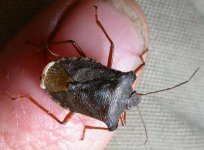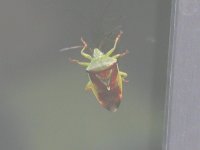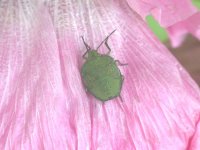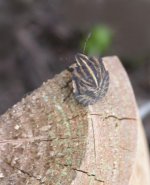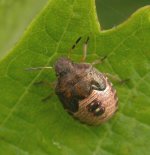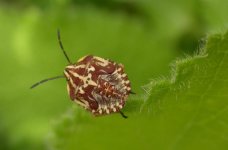They were at the Actinic though I did have singles of forester and Hawthorn at an MV.harry eales said:Just out of curiosity Angus, was the trap that caught your big catch of Shieldbugs, MV or Actinic?
Harry
-
Welcome to BirdForum, the internet's largest birding community with thousands of members from all over the world. The forums are dedicated to wild birds, birding, binoculars and equipment and all that goes with it.
Please register for an account to take part in the discussions in the forum, post your pictures in the gallery and more.
You are using an out of date browser. It may not display this or other websites correctly.
You should upgrade or use an alternative browser.
You should upgrade or use an alternative browser.
Shieldbugs. (4 Viewers)
- Thread starter Tammie
- Start date
More options
Who Replied?harry eales
Ancient Entomologist
Angus T said:They were at the Actinic though I did have singles of forester and Hawthorn at an MV.
Thanks Angus,
I'll have to dust off my actinic trap and give it a go. I seldom use it unless working in an area where lugging a generator it too much like hard work.
Harry
harry eales
Ancient Entomologist
Angus T said:Harry,
What do you make of this one, Slightly different from all the other Forest Shieldbugs. Apeared to be more round and lacking the orange spot. Is it a different species?
Hello Angus,
It is a Forest Shieldbug, it's just lacking the spot on the scutellum. All the other characters fit, i.e. Shield shape and the red legs. It's just one of the occasional variants I mentioned earlier in this thread.
Harry
Hi,
if anyone wants a good cheap reference to Shieldbugs the Field Studies Council do an excellent chart on how to id all the British ones for £2.50 + £1 p&p and it is very good. You can get them via their web site
http://www.field-studies-council.org/publications/pubsinfo.aspx?Code=OP85
I've got one and it is excellent. Some of the common names are a little different from the ones Harry uses as it says they are not standardised (ie Forest is called Red-legged) but latin names all the same.
Harry - if I start recording Shieldbugs in mapmate is there somewhere to report them to via mapmate or should I just send an extract to somewhere (you?).
This morning I had 5 birch and 1 forest in the MV trap which are my first for a while
Regards,
Jamie
if anyone wants a good cheap reference to Shieldbugs the Field Studies Council do an excellent chart on how to id all the British ones for £2.50 + £1 p&p and it is very good. You can get them via their web site
http://www.field-studies-council.org/publications/pubsinfo.aspx?Code=OP85
I've got one and it is excellent. Some of the common names are a little different from the ones Harry uses as it says they are not standardised (ie Forest is called Red-legged) but latin names all the same.
Harry - if I start recording Shieldbugs in mapmate is there somewhere to report them to via mapmate or should I just send an extract to somewhere (you?).
This morning I had 5 birch and 1 forest in the MV trap which are my first for a while
Regards,
Jamie
harry eales
Ancient Entomologist
J Duffie said:Hi,
if anyone wants a good cheap reference to Shieldbugs the Field Studies Council do an excellent chart on how to id all the British ones for £2.50 + £1 p&p and it is very good. You can get them via their web site
http://www.field-studies-council.org/publications/pubsinfo.aspx?Code=OP85
I've got one and it is excellent. Some of the common names are a little different from the ones Harry uses as it says they are not standardised (ie Forest is called Red-legged) but latin names all the same.
Harry - if I start recording Shieldbugs in mapmate is there somewhere to report them to via mapmate or should I just send an extract to somewhere (you?).
This morning I had 5 birch and 1 forest in the MV trap which are my first for a while
Regards,
Jamie
Hello Jamie,
I would be gratefull to you for any and all records of Shieldbugs you find in either Northumberland or Durham (my recording area) The species name and number of specimens, date and place of capture and the Grid Ref would be very helpful indeed. I pass on all the records I get to Bernard Nau the National Recorder.
Only about half the Shieldbugs have got common English names and there have been several attempts to get a standardised list, apparently without much luck. I'll have a look at the FSC wall chart., thanks for the info.
Harry
harry eales
Ancient Entomologist
Angus T said:Got a Green Shieldbug last night, assume its another widely distributed one.
Hello Angus,
On the British mainland the Green Shieldbug seems to be fairly common from Yorkshire/Lancashire southwards. It's certainly rare in my area with less than ten records over the last 100 years. I have only one record for the last 10 years, and haven't seen it at all myself. Sorry I can't you with its current distribution in the Emerald Isle.
I do have a locally caught specimen of a continental species Nezzara viridula which is sometimes imported from the continent in fruit or vegetables. (My specimen was in a bunch of grapes) This species has, within the last couple of years, become established as a breeding species in one or two localities on the south coast of England. It is often confused with the Green Shieldbug as it is very similar. Do you have a photo of your specimen?
Harry
harry eales
Ancient Entomologist
simondix said:Had these two what I presume are Shield Bugs in my garden today and yesterday. Anybody help with ID. I cannot find them in Chinery
Hello simon,
I'm not surprised you couldn't find them in Chinery, it's not a good book for identifying much in the way of anything but a few generally common species. It fall into what I call the cheap and cheerful books, but you really need specialist books for IDing any specific group.
Your first specimen is the Juniper Shieldbug Elasmostethus tristriatus Rather similar to the Birch Shieldbug. Once a species confined to Juniper it is now very widespread over a large area of southern England and found feeding on Lawsons' cypress and other closely related plants. In northern England it can still be found on wild Juniper. It is unrecorded for Scotland.
Your second picture is that of a final instar nymph of the Green Shieldbug Palomena prasina Again a common species in southern England to Yorkshire.
Harry
Grrrr, I have just found out some bar steward has changed the name of the Juniper Shieldbug You may find it listed as Cyphostethus tristriatus. Please excuse me while I go and tear out the remains of my hair. lol.
Last edited:
I didn't bother with photo as it matched Brian's excellent photo of Green Shieldbug in post #42. Also saw a nymph that matched another photo somewhere on this thread that was IDed as a Green Shieldbug.harry eales said:Do you have a photo of your specimen?
Harry
harry eales
Ancient Entomologist
Angus T said:I didn't bother with photo as it matched Brian's excellent photo of Green Shieldbug in post #42. Also saw a nymph that matched another photo somewhere on this thread that was IDed as a Green Shieldbug.
Hello Angus,
No problem, as long as your happy. I have had a word with Chris about your Sticky idea, and he's working on it.
By the way I have just obtained a copy of The Butterflies of Ireland by Norman Hicken, an interesting book, though a shame it was published before Real's Wood White was found. Perhaps someone will revise it in the future as Norman isn't around any more.
Harry
harry eales
Ancient Entomologist
Hello Simon,simondix said:Harry,
Thanks for that. Chinery actually shows a Green Shield Bug Nymph. It does, however, not look like this one in the picture. Whether that is the painting or it is a different instar. Thanks again for your help.
Simon
No problems, i'm always willing to help where I can.
Yes, Shieldbug nymphs do change colour and markings in their different instars, which is handy when identifying them, provided you know what each instar looks like.
As I said in my earlier post Chinery isn't much good for serious identification. I have a copy which I bought when it first came out. After reading it I consigned it to a box in the loft where has remained ever since.
The great problem in getting your hands on a serious book on identification is that once you are past the Butterfly, Moth and Dragonfly books, finding volumes relating to less popular species or groups is more difficult, unless you know where to look. Publishers seldom advertise low production publications as there is little profit in it.
There are several on-line bookshops, one of these specialising in natural history subjects is:-
http://www.nhbs.com
There are several others dealing with new and secondhand books on insects and other wildlife forms. I find eBay a useful way of getting secondhand books on insects but I always check what dealers are charging for the same book before bidding. I have seen some books with a starting price three or four times what you would pay a dealer for the same item. Having said that, I have picked up a lot of bargains. If you are looking for a specific title that is out of print, try:-
http://www/abebooks.com
Just type in the name of the author, surname before initials, and the name of the book and see if there are any hits, there are 13,000 bookshops in the group, you may just get lucky.
Harry
Fuchsia
Bug Babe
Hello Harry (and co),
I have 2 un-named shields and wonder if you can have a look. I think one is a nymph and the other is just odd! Hopefully they are both Europe wide species. Both taken in August.
Thanks again
Jen :h?:
I have 2 un-named shields and wonder if you can have a look. I think one is a nymph and the other is just odd! Hopefully they are both Europe wide species. Both taken in August.
Thanks again
Jen :h?:
Attachments
harry eales
Ancient Entomologist
Fuchsia said:Hello Harry (and co),
I have 2 un-named shields and wonder if you can have a look. I think one is a nymph and the other is just odd! Hopefully they are both Europe wide species. Both taken in August.
Thanks again
Jen :h?:
Hello Jen,
I'm afraid I am not going to be a lot of help here, neither species are British. The first pic is at an awkward angle for ID purposes, all I can say is that it is similar to or may be Graphosoma lineatum The nymph I don't know at all, or do I have many pictures of European nymphs
Sorry, but that's the best I can do, there is a far larger number of Shieldbug species on the continent, than here in Britain. Whenever possible try and get a shot of adults from directly above the insect so that it's full shield shape is visible.
Harry
Fuchsia
Bug Babe
harry eales
Ancient Entomologist
Fuchsia said:Thanks for looking Harry, I wasn't too hopeful of them being UK species.
No 1 was a fast little thing - I think this may be the same species (found in a different file - taken 21st July) just in case any one else can help.
Cheers
Jen
Morning Jen,
A nice picture, and I have got this one, it's Carpocoris purpureipennis, a late instar nymph. Quite a colourful little bug (ger). lol. My source reference for this is Wanzen und Zikaden, a German book on various Hemiptera found in western Europe.
Harry
harry eales
Ancient Entomologist
Fuchsia said:See Harry! You're a star - thanks.
Jen
Hi Jen,
More like a drawing pin, now this thread is a 'sticky'. lol.
Harry
Users who are viewing this thread
Total: 5 (members: 0, guests: 5)




